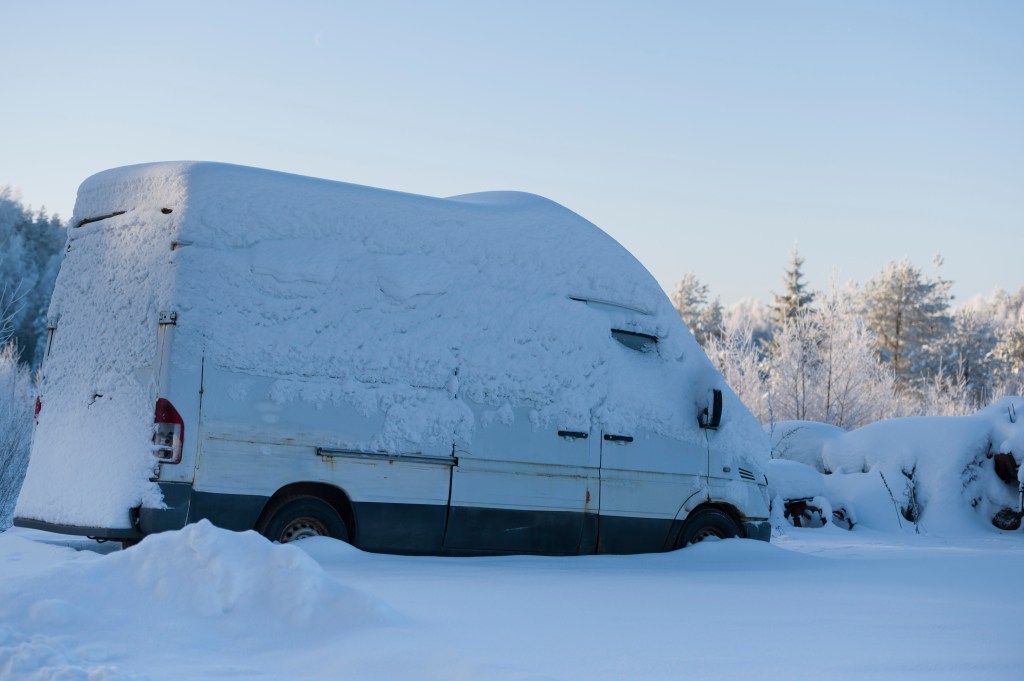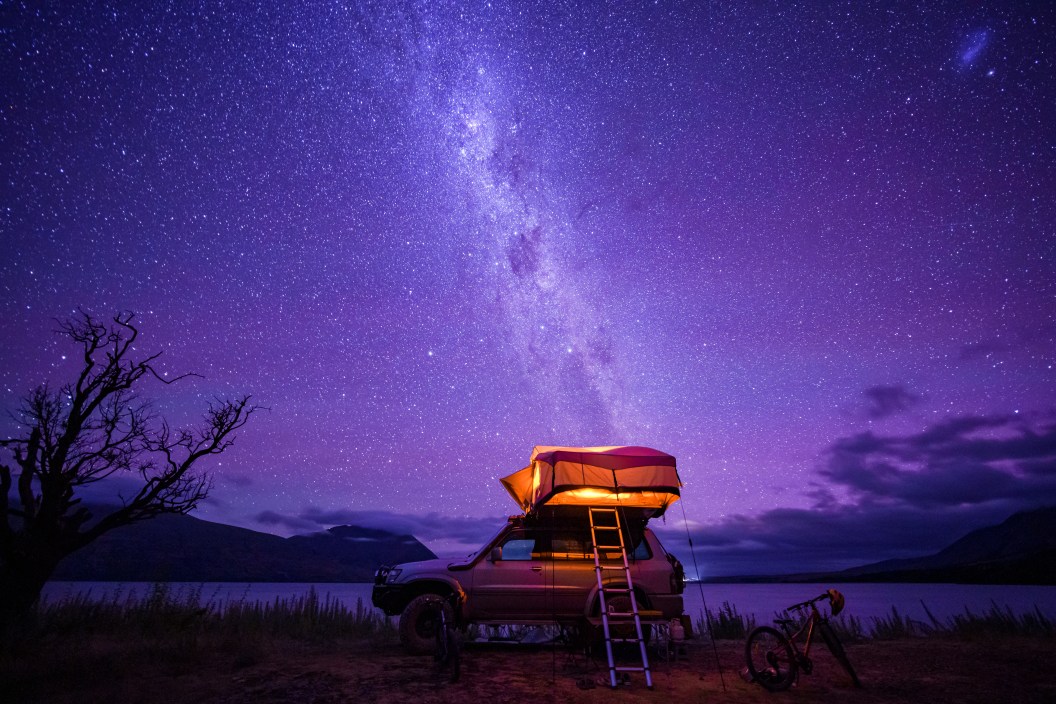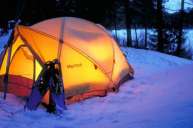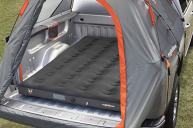Traditionally, car camping is when you drive your car to a campsite and take advantage of all the storage inside a vehicle—and the short distance from where you park to where you camp—to bring along all the creature comforts to make the great outdoors your home away from home. That's not the car camping I'm talking about. In this case, I'm talking about camping in my car, a form of boondocking or stealth camping.
Between vacations and emergencies, I've spent over 50 winter nights camping in my car so far, and I can't recommend it enough. For one, you don't have to set up a campsite at all; you can pull over and sleep just about anywhere. It also saves money, since you don't need to reserve a campsite or pay for a hotel. Honestly, though, the best part about winter camping in your car is that if you get cold, you can simply turn the heat on.
An often overlooked benefit of sleeping in your car is increased safety. Whether it gets too cold out, the snow is coming down hard, a mountain lion or bear shows up at your campsite, or a strange vehicle pulls up next to yours, you can just hop into the driver's seat and leave.
Here are my well-earned best practices and gear recommendations to ensure a safe and enjoyable experience while winter car camping.
Winter Car Camping in SUVs Versus Vans

Getty Images, amriphoto
Think of the SUV versus Sprinter-type van comparison like a Venn diagram. That is, SUVs and vans overlap in some areas and differ in others.
The list of similarities between vans and SUVs is long. Obviously, they're both vehicles. You don't need a special license to drive either one. They have very similar maintenance needs and feature similar amenities. However, adventure vans, which include the Mercedes Sprinter, Dodge Promaster, and Ford Transit, can take car camping to a whole new level.
Car Camping in an SUV
SUVs tend to be less glamp-y, more compact, and more affordable than a van. SUVs require you to fold the back seats completely flat or remove them altogether for the most comfortable sleeping setup—which also cuts down on available storage for additional gear compared to vans.
When I winter car-camp, I create a cozy bed in the back of my RAV4 using two 2-inch memory foam sleeping pads, a -50-degree rated sleeping bag, a wool blanket, a down comforter, and three pillows. With all this warm bedding, the cold doesn't wake me, and I get an incredible night's rest. Outfitted thusly, you may not miss that an SUVs doesn't come with bunk beds, lighting features, kitchen areas, or composting toilets, like vans do.
In addition, SUVs are also more rugged in terms of off-road capabilities, which allow you to take an SUV almost anywhere, depending on your tires, lift, and four-wheel drive. If you plan on adventuring down gnarly dirt roads to get into hunting spots, backcountry skiing locations, or other off-the-beaten-path outdoor activities, an SUV may be a better choice.
Car Camping in a Van
Admittedly, I've never car-camped in a van. However, I've toured quite a few, and they're certainly more glamorous than your average SUV. A vast array of vans are tricked out for car camping. Honestly, some of them are more like tiny homes than a vehicle. If you're fortunate enough to own such a van, you're probably aware of the unlimited #vanlife inspiration available online. A quick look gives the impression that winter car camping can be extremely pleasant in an insulated van with heaters, built-in window coverings, full-size mattresses, and electrical converters that simplify charging your devices and plugging in an electric blanket.
That said, Sprinter vans and their ilk are a serious financial investment—starting at $50k new—for the comfort of home while you're on the road. If you've got cash to burn and easy camping is your priority, you may consider shopping for one. Comparatively, an SUV might not have a lengthy list of amenities, but it will get you where you need to go and then some within a more typical vehicle price range.
Winter Car Camping in Pickup Trucks

Getty Images, milehightraveler
Pickup trucks are a different ball game than SUVs and Sprinter vans when it comes to camping in the winter. If you car-camp in your pickup truck, there's a 99 percent chance you'll sleep in the bed. On its own, a truck bed isn't exactly the definition of comfy-cozy. However, with a few upgrades, your truck bed can easily become your home away from home.
There are two main differences between trucks and other car-camping setups. The first is that the sleeping area is separate from the vehicle's interior. You must exit the cab and enter the bed by getting out of the car or climbing through the back window. The second is that truck beds need a topper to protect you from the elements. Without a topper, you won't want to sleep in your truck bed in February.
That means you must think about your truck camping setup differently. You can't turn the truck on to heat your sleeping space, so how will you keep warm? Will you sleep directly on the bed lining or install a bed frame? How will you separate your gear from your sleeping area?
Most truck-based car campers install a bed topper. Hard tops work best in the winter for protection and some insulation, but fabric ones will at least keep the snow off their sleeping setup. Then, they buy a portable Buddy heater or another that's safe for indoor use, and a battery-powered smoke and carbon monoxide detector to go along with it, just in case.
From there, they either keep it simple and lay out sleeping pads, bags, and blankets directly on the bed liner or get fancy and install a bed frame system. Both custom-built and pre-made truck bed sleeping platforms are popular. Most store-bought options feature an elevated sleeping area and storage compartments that slide out from underneath. Custom builds can get crazy, depending on what features meet camping needs.
Supplies You'll Need to Winter Car Camp

Getty Images, mikexavier
Before winter car camping, create a supply list. Mine for SUV camping includes:
This includes a sleeping pad, blankets or a sleeping bag (or both), and a pillow (or three). Ball out when it comes to your sleeping gear. When planning your setup, consider all the times you've been uncomfortable in your tent. What could have made that experience better? More padding? Warmer bedding? A full-size pillow? Bring these extra items along when car camping to ensure you get a good night's rest.
I also recommend that you cut out some window covering from Reflectix. This insulative layer helps keep your body heat inside the cabin—and prevents the sun from waking you earlier than you'd like. I use battery-powered string lights over where I sleep so I don't need to use my car's battery to light up my vehicle at night.
Pack at least a couple days' worth beyond what you expect to need in case you get snowed in or have car trouble. If you'll be in sub-freezing conditions, use insulated water bottles to help prevent their contents from freezing.
The cold can sap the rechargeable batteries in your phone and emergency devices faster, and you'll want backups for anything that's powered by regular alkaline batteries.
Anything can happen while car camping, so you must be prepared for whatever nature or the travel gods throw at you. This includes flashlights and a first aid kit, just to start. A small snow shovel and a window brush are no-brainers if you'll be driving where it snows.
Portable jump starters and back-up jumper cables can save you if your car battery dies. Making sure your spare tire is good to go and you have the tools to change your tire if need be is essential. Portable tire inflators can pump up tires that have decreased in pressure with the cold. Traction boards can help get you unstuck in freshly fallen snow, and don't forget to keep a tow strap, hook, and chain handy, especially if your car doesn't have a winch on it.
Once your vehicle emergency equipment is ready, focus on your personal emergency gear. I keep a camping stove, freeze-dried meals, and extra water in my car in case I get stuck in the cold for longer than expected. Hand warmers and paper maps can come in handy, too.
As an added safety precaution, I car-camp with pepper spray, particularly if I'm alone. A satellite communicator like the Garmin InReach can keep you in touch if you become stranded outside of cell phone range. If I'm camping in an area known for bears or mountain lions, I bring bear spray, too.
If you go winter car camping with your dog like I do, pack extra food, water, and a leash for your pup. Save the number and address of the closest veterinarian to wherever you're camping in case your dog experiences an emergency. If you're camping out of cell service, the last thing you'll want to do is panic about finding a vet.
Things to Keep in Mind When Winter Car Camping

Getty Images, fotojv
Having the right gear is only part of the prep. You'll also want to have a mental game plan.
Plan for the worst-case scenarios.
Before you head off on your wintry adventure, make an emergency game plan. In fact, make several of them. Know what you're going to do ahead of time if the weather turns south. Have a backup plan if your first camping spot doesn't work out. Know where the closest town is in case you need help or supplies. Lastly, have a plan in place in case a suspicious person or dangerous animal approaches your vehicle.
Keep an eye on the weather.
If you've ever spent time outdoors in the winter, you know how quickly the conditions can change. You can have a clear bluebird sky in the morning, then black snow clouds fill the horizon by noon. Similarly, daily highs may be above freezing, but nightly temps may dip into the negatives. Keep an eye on the weather where you're starting and along the way to your destination, and use your backup plans if necessary.
Know when to call it quits.
Don't be afraid to use your emergency plans. Sure, maybe it's lame to end your winter trip early. But knowingly putting yourself in danger is downright dumb. There's no shame in turning back. Your loved ones will be glad you stayed safe.
Your Questions, Answered
Should you car-camp alone?
Depending on your comfort levels, you may not want to camp alone. Consider asking a friend to join you, especially if you both fit in one vehicle. If they drive themselves, consider using two-way radios so you can chat in your respective vehicles or outside of cell service.
Car camping alone is fun, too. It gives you a sense of total freedom; you can go anywhere and do anything. Usually, I car-camp with my dog. She's great company, doesn't take up much room, and travels well.
What kinds of cars are the easiest to sleep in?
Depending on your body size, some cars may be better for sleeping in than others. For example, I am a small-framed, 5-foot-4-inch human, and I fit perfectly in the back of my RAV4. However, my friend Dan is 6-foot-3 and he has to fold himself up to fit.
Vehicles with seats that fold down flat are the best for sleeping in. Some car seats fold down at an angle; this is not ideal as you'll end up sliding one way or the other while you sleep. Of course, most passenger vans have actual beds, so you won't need to worry about this.




